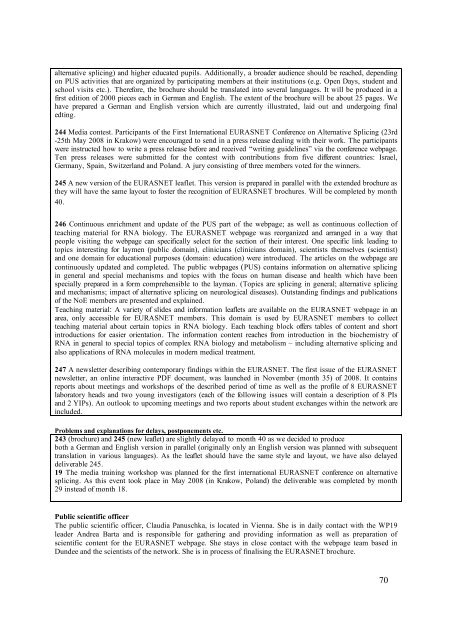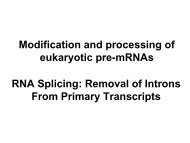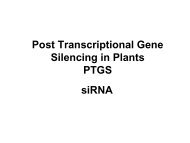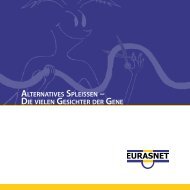You also want an ePaper? Increase the reach of your titles
YUMPU automatically turns print PDFs into web optimized ePapers that Google loves.
alternative splicing) and higher educated pupils. Additionally, a broader audience should be reached, dependingon PUS activities that are organized by participating members at their institutions (e.g. Open Days, student andschool visits etc.). Therefore, the brochure should be translated into several languages. It will be produced in afirst edition of 2000 pieces each in German and English. The extent of the brochure will be about 25 pages. Wehave prepared a German and English version which are currently illustrated, laid out and undergoing finaledting.244 Media contest. Participants of the First International <strong>EURASNET</strong> Conference on Alternative Splicing (23rd-25th May <strong>2008</strong> in Krakow) were encouraged to send in a press release dealing with their work. The participantswere instructed how to write a press release before and received “writing guidelines” via the conference webpage.Ten press releases were submitted for the contest with contributions from five different countries: Israel,Germany, Spain, Switzerland and Poland. A jury consisting of three members voted for the winners.245 A new version of the <strong>EURASNET</strong> leaflet. This version is prepared in parallel with the extended brochure asthey will have the same layout to foster the recognition of <strong>EURASNET</strong> brochures. Will be completed by month40.246 Continuous enrichment and update of the PUS part of the webpage; as well as continuous collection ofteaching material for RNA biology. The <strong>EURASNET</strong> webpage was reorganized and arranged in a way thatpeople visiting the webpage can specifically select for the section of their interest. One specific link leading totopics interesting for laymen (public domain), clinicians (clinicians domain), scientists themselves (scientist)and one domain for educational purposes (domain: education) were introduced. The articles on the webpage arecontinuously updated and completed. The public webpages (PUS) contains information on alternative splicingin general and special mechanisms and topics with the focus on human disease and health which have beenspecially prepared in a form comprehensible to the layman. (Topics are splicing in general; alternative splicingand mechanisms; impact of alternative splicing on neurological diseases). Outstanding findings and publicationsof the NoE members are presented and explained.Teaching material: A variety of slides and information leaflets are available on the <strong>EURASNET</strong> webpage in anarea, only accessible for <strong>EURASNET</strong> members. This domain is used by <strong>EURASNET</strong> members to collectteaching material about certain topics in RNA biology. Each teaching block offers tables of content and shortintroductions for easier orientation. The information content reaches from introduction in the biochemistry ofRNA in general to special topics of complex RNA biology and metabolism – including alternative splicing andalso applications of RNA molecules in modern medical treatment.247 A newsletter describing contemporary findings within the <strong>EURASNET</strong>. The first issue of the <strong>EURASNET</strong>newsletter, an online interactive <strong>PDF</strong> document, was launched in November (month 35) of <strong>2008</strong>. It containsreports about meetings and workshops of the described period of time as well as the pro<strong>file</strong> of 8 <strong>EURASNET</strong>laboratory heads and two young investigators (each of the following issues will contain a description of 8 PIsand 2 YIPs). An outlook to upcoming meetings and two reports about student exchanges within the network areincluded.Problems and explanations for delays, postponements etc.243 (brochure) and 245 (new leaflet) are slightly delayed to month 40 as we decided to produceboth a German and English version in parallel (originally only an English version was planned with subsequenttranslation in various languages). As the leaflet should have the same style and layout, we have also delayeddeliverable 245.19 The media training workshop was planned for the first international <strong>EURASNET</strong> conference on alternativesplicing. As this event took place in May <strong>2008</strong> (in Krakow, Poland) the deliverable was completed by month29 instead of month 18.Public scientific officerThe public scientific officer, Claudia Panuschka, is located in Vienna. She is in daily contact with the WP19leader Andrea Barta and is responsible for gathering and providing information as well as preparation ofscientific content for the <strong>EURASNET</strong> webpage. She stays in close contact with the webpage team based inDundee and the scientists of the network. She is in process of finalising the <strong>EURASNET</strong> brochure.70







